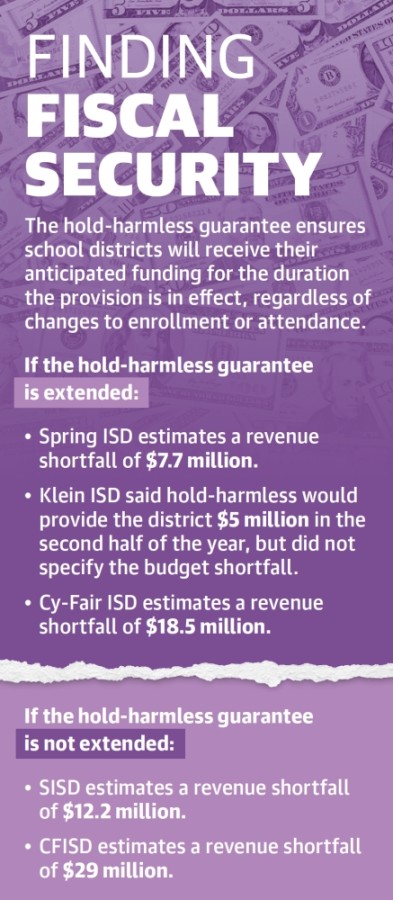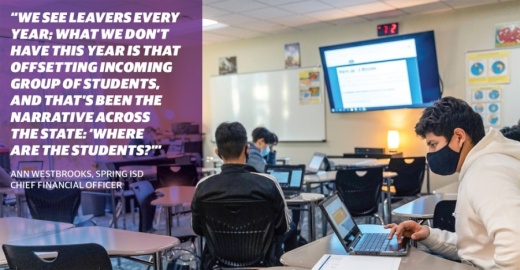As of Jan. 6, the enrollments of KISD, SISD and CFISD are less than district projections by 2,209 students, 1,630 students and 3,359 students, respectively, according to the districts.
“We see leavers every year; what we don’t have this year is that offsetting incoming group of students, and that’s been the narrative across the state: ‘Where are the students?’” SISD Chief Financial Officer Ann Westbrooks said during a Dec. 3 board meeting. “They’re not showing up somewhere else, so that’s a bit perplexing.”
As student enrollment projections influence how school districts plan staffing for the school year, SISD is overstaffed by 71 positions, and CFISD—the third-largest school district in Texas—still has 141 vacant teaching positions. While KISD experienced overstaffing earlier this school year, Robert Robertson, associate superintendent of facility and school services, said that has since been resolved.
 “This overstaffing was addressed through reassignment of personnel and absorbing vacancies as they occurred throughout the semester,” he said.
“This overstaffing was addressed through reassignment of personnel and absorbing vacancies as they occurred throughout the semester,” he said.Staffing is not the only factor influenced by enrollment. Average daily attendance is used in state funding formulas to calculate the amount of funds to which a district is entitled, according to the Texas Education Agency.
The TEA implemented a hold-harmless guarantee for the first semester of the 2020-21 school year, meaning school districts received their anticipated funding regardless of changes to enrollment. But the TEA has not extended the guarantee to the spring semester as of press time Jan. 19.
As a result, education leaders are urging the TEA to extend the hold-harmless guarantee for the remainder of the 2020-21 school year to save critical revenue streams that, if lost, could result in layoffs, hiring freezes or program cuts for local school districts.
“Students come first; that has not changed because we’re in a pandemic,” Westbrooks said. “But we are ... closing vacancies in areas where we have overages, and we’re holding off on hiring in areas where we can.”
Fighting for finances
Without a hold-harmless guarantee extension, district officials said SISD is facing a revenue shortfall of roughly $12.2 million. If the provision is extended, that shortfall will be cut to $7.7 million.
 In hopes of advocating for an extension, the SISD board of trustees adopted the hold-harmless guarantee as one of its priorities for the 87th Texas Legislature, which began Jan. 12.
In hopes of advocating for an extension, the SISD board of trustees adopted the hold-harmless guarantee as one of its priorities for the 87th Texas Legislature, which began Jan. 12.“The long-term impact of COVID-19 is going to be felt on our operations and our financial performance for quite some time,” Westbrooks said.
Similarly, CFISD is facing an estimated revenue shortfall of either $18.5 million with the extension or $29 million without it.
By contrast, KISD Chief Financial Officer Dan Schaefer said the district does not expect long-term budgeting effects due to COVID-19. However, KISD is also advocating for an extension.
“Based on fall enrollment, the hold harmless for the second half of the year would be approximately $5 million in revenue,” Schaefer said. “If more students return in the spring, then the revenue loss would be lower.”
School districts are not the only ones advocating for the extension: The Houston Northwest Chamber of Commerce sent a letter to TEA Commissioner of Education Mike Morath in mid-December, in solidarity with local school districts.
“We felt that it was important for the state to not punish the school districts by eliminating their funding because of something that is completely out of their control,” Chamber President and CEO Bobby Lieb said.
At the state level, 82 members of the Texas Legislature—including state Rep. Sam Harless, R-Spring—signed a Dec. 18 letter pushing for the extension.
“Our urgent concern is that, if the hold harmless is not extended for the second semester, the process of making difficult and harmful decisions to reduce staff, in addition to cutting programs for students, may be forced on school districts immediately. We must not let this happen,” the letter reads.
Lost students
School districts statewide are experiencing similar trends in enrollment, said Bob Popinski, the director of policy for advocacy group Raise Your Hand Texas.
“What we’re hearing—especially in urban and major suburban areas—is that there’s sometimes a 4% decline or more [in enrollment], so that’s tens of thousands of students not getting in-person instruction or remote learning,” Popinski said.
In the seven-county Greater Houston area, which includes 1.2 million students, Pam Wells, the executive director of the Region 4 Education Service Center, said an estimated 45,000 students are unaccounted for. Sixty-two percent of those students are in pre-K to second grade and nearly 12,000 of those students were expected to enroll in pre-K this school year, she added.
 This issue is one Popinski said school districts across the state are likewise experiencing.
This issue is one Popinski said school districts across the state are likewise experiencing.“That’s a problem because now you have learning loss and some of the most beneficial programs for these kids—they’re not showing up for,” he said. “What will that do in the future for their learning gains?”
In addition to delaying the start of education, districts have also lost students to the pandemic-induced economic downturn, officials said.
“Many people lost their jobs, and when that happens, some people can’t make rent, and they relocate,” Lieb said. “In many cases, [school district officials are] going to the [student’s] place of residence and finding that it has been vacated.”
While some students may have moved to other school districts, charter schools or private schools or switched to home schooling, district officials are also concerned about truancy. SISD Superintendent Rodney Watson said while the district typically hosts one truancy walk per year to track down disengaged students, SISD has already held two such events this year.
Wells said districts often find out a student is enrolled in another district or public school because the receiving school will request records from the student’s previous school.
“Our school leaders say that for many of these students, there have not been requests for school records, so there is no way to know if parents are home schooling, keeping their children at home or have moved,” Wells said.
The long-term effects of what education leaders are calling the “COVID-19 slide” are still not yet known as the pandemic continues to rage amid early vaccine rollout. However, district officials are banking on mitigating educational loss through targeted interventions—programs that could potentially be cut without a hold-harmless guarantee extension.
“Early literacy is critically important for future success, and it becomes more and more difficult to close gaps the longer children are out of school,” Wells said.
Andy Li contributed to this report.





